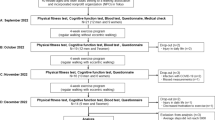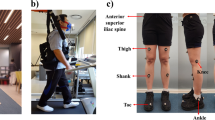Abstract
To understand the physical and other factors related to walking among the elderly residents of a Care House for the aged, the total number of steps walked were measured over a period of 1 week (Nov. 6–12. 1994) for 67 female residents (mean age 79 ± 1 years). In addition, walking speed, stride length, and the time to climb 15 steps (stair-climbing time) were measured. To understand the indirect factors such as balance and agility that may control walking, tests were conducted on the subjects’ ability to stand on one leg with eyes open and closed, and jumping reaction time. Results showed a negative correlation between total number of steps and age (r=-0.543, P< 0.01), jumping reaction time (r=-0.258, p<0.05) and stair-climbing time (r=-0.501, P< 0.01).
However, a positive correlation was found between total number of steps and stride length (r=0.408, P< 0.01), walking speed (r=0.419, P< 0.01), self-rated health (r= 0.390, P< 0.05) and standing on one leg with eyes closed (r=0.258, P< 0.05). The total number of steps walked and physical factors, particularly physique and balance, were also closely related. The above suggests that a walking habit among elderly persons helps to slow the decline in physical strength, which is necessary to prevent falls. It is also reflected in the person’s awareness of health and may increase the opportunities for leading an active daily life.
Similar content being viewed by others
References
Levin HS, Benton AL. Age effects in proprioceptive feedback performance. Geront Clin 1973; 15:161–9.
Jette M, Sidney K, Campbell J. Effects of a twelve-week walking programme on maximal and submaximal work output indices in sedentary middle-aged men and women. J Sports Med 1988; 28:59–66.
Paffenbarger RS. Jr, Hyde RT, Wing AL, Lee I-Min, Jung DL, Kampert JB. The association of changes in physical activity level and other lifestyle characteristics with mortality among men. The New Eng J of Med 1993; 328:538–45.
Rikli RE, Edwards DJ. Effects of a three-year exercise program on motor function and cognitive processing speed in older women. RQES 1991; 62:61–7.
Pollock ML, Foster C, Knapp DJ, Schmidt DH. Effect of age and training on aerobic capacity and body composition of master athletes. J Appl Physiol 1987; 62:725–31.
Takeshima N, Tanaka K, Kobayashi F, Watanabe T, Nakata M. Effects of walking habit on aerobic work capacity and vital age in middle-aged and elderly walkers. Jpn J Phys Fitness Sports Med 1996; 45:387–94.
New PK, Ruscio AT, Priest RP, Petritsi D, Geoug LA. The support structure of heart and stroke patients. A study on the rouge of significant other in patients rehabilitation. Soc Sci Med 1968;2:185–200.
Ootuka T. Use of pedmeters from the viewpoint of sports medicine, (in Japanese) Jpn J Clinical Sports Medicine 1992; 9:143–7.
Tujii I, Minami Y, Penelope MK, Hisamichi S, Asano H, Sato M. The predictive power of daily living and ambulatory activity for cause-specific mortality among the elderly: A tree- year follow-up in urban Japan. Am Gertiarics Soci 1994; 42:153–6.
Sidney K, Downs TD, Cash HR, Grotz RC. Progress in development of the index of ADL. Gerontologist 1970; 1:20–30.
Shibata,H, Haga H, Nagai H, et al. Predictors of all-cause mortality between ages 70 and 80: The Koganei study. Arch Gerontol Geriatr 1992; 14:283–97.
Terasaki H, Umesato Y, Kubo Y, Ohmichi H. A comparative study on long- term care facilities for the aged in Japan. Jpn Society of Public Health 1994; 41:671–81.
Sato T, Murase T, Fujii T, Iwao S, Kobayashi Y, Sato Y. Relationship of health and physical fitness in middle-aged and elderly men and women. Jpn J Phys Fitness Sports Med 1996; 45:357–64.
Furuna T, Nagasaki H, Ito H, Hashizume K, Kinugasa T, Maruyama H. Motor abilities of older adults in Japanese urban and rural communities. Jpn J Phys. Fitness Sports Med 1995; 44:347–56.
Matubayashi K, Okimura K, Wada T, et al. Comparative study of activity of daily living in the elderly between in Kahoku and in Yaku. Jpn J Geriat Soci 1994; 31:759–67.
Doherty JT, Vandervoort AA, Taylor AW, Brown WF. Effects of motorunit losses on strength in older men and women. J Appl Physiol 1993; 74(2):868–74.
Bemben MG, Massey BH, Bemben DA, Misner JE, Boileau RA. Isometric muscle force production as a function of age in healthy 20-to 74-yr-old men. Med Sci Sports Exerc 1991; 23:1302–10.
Fishen NM, Pendergast DR, Calkins EC. Maximal isometric torgue of knee extension as a function of muscle length in subjects of advancing age. Arch Phys Med Rehabil 1990; 71:729–34.
Kaneko M, Morimoto Y, Kimura M, Fuchimoto K, Fuchimoto T. A kinematic analysis of walking and physical fitness testing in elderly women. Can J Sport Sci 1991; 16:223–8.
Kimura M, Tokuhiro M, Okayama Y, Okuno T, Nakao T. Evaluation of balance function in the aged using closed-eye and open-eye one-foot balancing test. Report of Research Center for Physical Education. 1996; 24:118–29.
Haga H, Shibata H, Shichita K, Matsuzaki T, Hatano S. Falls in the institutionalized elderly in Japan. Gerontol Geriatr 1986; 5:1–9.
Campbell AJ, Borrie MJ, Spears GF. Risk factors for falls in a community, based prospective study of people 70 years and older. J Gerontol 1989; 44:112–7.
Arao T, Oida Y, Nagamatsu T. Functional fitness and related factors in community-dwelling elderly. Jpn Society of Public Health 1998; 45:396–406.
Author information
Authors and Affiliations
Rights and permissions
About this article
Cite this article
Yanagimoto, Y., Oshida, Y. & Sato, Y. Physical factors affecting daily walking activities among elderly female residents of a care house. Environ Health Prev Med 4, 34–38 (1999). https://doi.org/10.1007/BF02931248
Received:
Accepted:
Issue Date:
DOI: https://doi.org/10.1007/BF02931248




